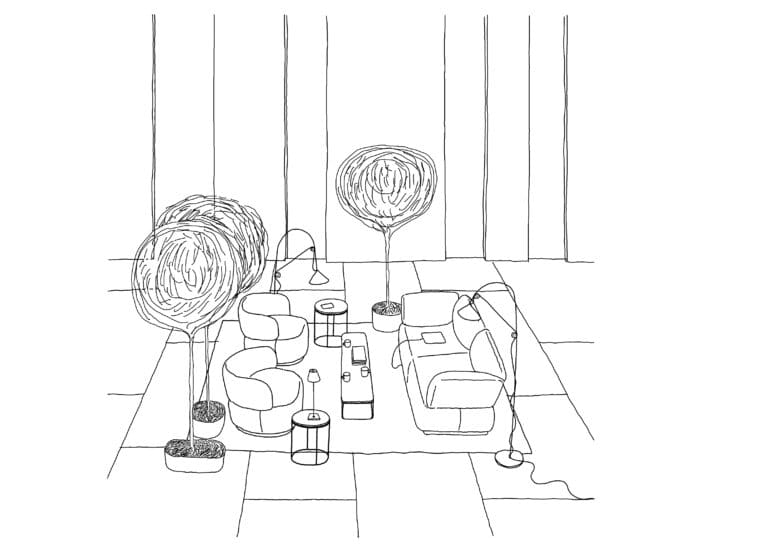We would like to get an honest assessment from you: What is the relationship between the sofa and the room in general?
It’s a very important relationship. In the world, every object relates to another. The teaspoon relates to the cup which relates to the table creating a sense of scale, proportion and colour balance. The car relates to the buildings which relate to the city, and so forth. In this specific case, the sofa is generally an important presence in the interior and for me, it has to be an object that does not scream to be seen but establishes right away a good relationship with the user. It has to be welcoming and inviting, creating a sense of harmony in itself.
Often the sofa is simply associated with “relax, after work, Netflix & chill.” As a designer, what other functions do you think a sofa serves?
Well, today we function in a different way than just 15 years ago. The world has changed many times and we have witnessed a technological revolution that was unimaginable even at the beginning of the 2000s. Relaxing after work for many people means more work but in a laid-back way. Checking emails until late in the evening and watching Netflix or engaging with social networks is something that we can do using one device… television these days is less of a priority. They are bigger, yes, but fixed in one position and not as flexible. Flexibility is what we are all looking for and in the case of a sofa, it could offer the customer the ability to carry out some work on integrated tables or charging their devices in a comfortable and relaxing way.
Sofa+office? Yes, it is possible. When did the triumph of the sofa in the office begin and what value has it gained in the working world?
A few years ago a “revolution” in the work environment began to grow. Planners, architects and designers were questioning the way people were working, and how they were spending time in the office. If it was necessary to be so desk-dependent. Covid dramatically accelerated this process while adding more seminal themes on the table. The answer is that for some kinds of activity, you don’t need a desk. Informal meetings or even proper lengthy meetings can be done on a sofa. Conference calls, job interviews, focused work, small group presentations and other light activities too. All these actions can be carried out on soft seating, in the company’s cafeteria or in a dedicated lounge space. These situations and this way of working encourage exchange rather than isolation and are more human-centric and less forced.

(Illustrations: Robin Rizzini)
What is elementary in the design for a sofa to be perceived as “comfortable, convenient, stylish”?
This is intangible. It is a balance of good design, good craftsmanship and years of experience and know-how from both the designer and the company!
What do you think a sofa must have to combine all the characteristics of a timeless classic?
Again, there is no exact rule. But I would say that if a designer can work well with the proportions, the details and the feeling of comfort, he is already going in the right direction. Then you have to be aligned with the company you work with because each company has its own desired language and tradition that needs to be interpreted and not taken in a completely different direction. Last, but not least, the market today is much less predictable than 20 years ago; a time when you could “plan” to design an evergreen or try to create a timeless classic.

Tell us more
Robin Rizzini was born in Genoa and has Italian-British roots. He completed his studies at the Scuola Politecnica di Design in Milan, where he has also been teaching Furniture Design in the master’s programme. In 2006 Robin Rizzini founded his own design office and three years later he co-founded the studio Metrica. Robin Rizzini has been an independent designer since 2018.
You recently designed the se:living sofa for Sedus. This is the first step into the soft seating market for the company. What design elements did you consider in your draft to make the product suitable for the office?
Being the first sofa seating system for Sedus and considering the highly technical heritage of the company, I thought it was a good idea to try and keep a balance between a well-proportioned and comfortable product with the addition of “active” elements like, for instance, connected tables. And with the addition of tables between seats, corner tables and freestanding tables, there is a complete range of surfaces which can be used with the system. Choose your space - from a simple informal meeting to group work or more engaging activities, either in a private office, a public area, a lounge area or a cafeteria.

The system is made up of elements that are all suitable for a contemporary office environment with the added value of introducing double-depth seating for a more informal way to meet and seat, asymmetric armchairs or angled modules for more intimate remote conversations. All models can be equipped with electric and USB connectors.

And a final personal question: What is the best way for you to relax after a long day at work? Maybe on the sofa?
Funnily enough, life brought me to a small apartment in Milan where I lived for a very long time without a sofa. Also, I do not have a television so I never had that urge to sit down and switch on the big screen. What I know is that my ideal sofa would have a lot of space, connectivity facilities and a few small surfaces around to put books, magazines, technology and drinks. My relaxation time is not always the same but I often think about a me-only time with a nice glass of wine and some late-night sketching or reading. Possibly on a terrace overlooking the Ligurian sea!
social media channels:


